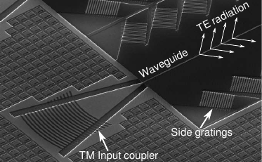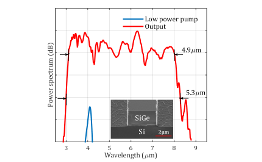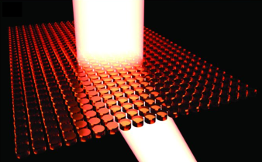OPTICA publication (20 April 2018)
Congratulations Milan and the team!
The mid-IR INL/ALPhFA team work on “Mid-infrared octave spanning supercontinuum generation to 8.5 μm in silicon-germanium waveguides” has been published in OPTICA (https://doi.org/10.1364/OPTICA.5.000360).
All chemical or biological molecules have a specific spectral signature in the mid-infrared (between 3 µm and 20 µm). The availability of compact and inexpensive light sources emitting in this spectrum would make it possible to develop numerous applications, in the environmental and industrial sectors (detection of gases in the air) as well as in the health sector, for example for the early diagnosis of cancer. In collaboration with CEA-LETI and our ALPhFA partners we have taken an important step in this direction by creating an integrated "supercontinuum" source, which emits between 3 µm and 8.5 µm, with sufficient power (10 mW) for the applications envisaged. The technology used is compatible with CMOS processes already used for mass production in microelectronics.
The supercontinuum source results from the broadening of the spectrum of an ultra-short pulse laser beam (femtosecond laser), using a highly non-linear waveguide integrated on a chip. To make this chip, researchers used silicon-germanium technology on a silicon (SiGe/Si) substrate. The emission spectrum could be extended to 8.5 µm, a first with a CMOS-compatible process. The low losses in the device made it possible to achieve an output power of more than 10 mW, which is much higher than that achieved so far with this type of device.
The potential applications are ranging from environmental monitoring, health and security.





